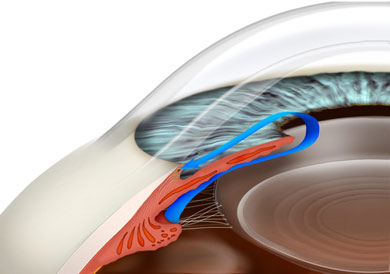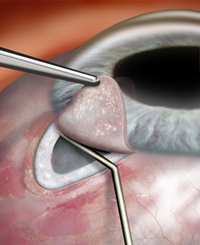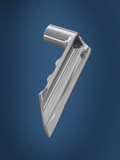
Glaucoma Risk Factors, Types, Diagnosis & Treatment
Glaucoma is an eye disease that is most commonly caused by an elevated pressure inside the eye-Intraocular Pressure (IOP)-that damages the optic nerve and causes loss of vision. Glaucoma can begin without any symptoms or obvious loss of vision and if not diagnosed early, treated properly and controlled, it will result in permanent vision loss and potentially blindness.
There are two main types of Glaucoma: Primary Open Angle Glaucoma (POAG), and Angle Closure Glaucoma. The most common type of glaucoma is Primary Open Angle Glaucoma (POAG) whereby the production and/or drainage of fluid inside the front of the eye-called aqueous humor-is imbalanced, resulting in an elevation in eye pressure (IOP) so that the circulation in the optic nerve becomes compromised, depriving it of oxygen and nutrients causing permanent changes and even damage to the optic nerve, which if left untreated result in vision loss and ultimately blindness.

The second type of glaucoma is called Angle Closure Glaucoma. Primary Angle Closure Glaucoma accounts for about 10% of all cases of glaucoma and about 2/3 of these produce no symptoms for patients. Acute Angle Closure Glaucoma is one of the only types of glaucoma that produces distinct symptoms that include pain, light sensitivity, redness, blurred vision, colored haloes around lights and nausea or vomiting. Acute Angle Closure Glaucoma is considered a medical emergency. If you experience a sudden onset of pain, redness, blurred vision, light sensitivity, haloes around lights, nausea and vomiting, please call Northwest Indiana Eye & Laser Center at 219-464-8223 and relay these symptoms to the receptionist so that you can be given an appointment immediately.
In the event that you are at risk for Angle Closure Glaucoma or in the event that you have Acute Angle Closure Glaucoma Dr. Scott Buck may initially prescribe some medication to begin to lower the pressure but will also perform a type of glaucoma laser procedure called Laser Iridotomy or “Laser PI” to produce a small opening or hole in the Iris so that Aqueous Humor can drain from the eye more effectively.
Depending on your general health, eye health and family history there are a number of factors that that may influence your likelihood of developing glaucoma. These include the following:
The eye doctors at Northwest Indiana Eye & Laser Center will perform a number of tests in order to provide you with early detection and make the most accurate diagnosis of glaucoma. These include the following:
There are three main methods that Dr. Scott Buck can use to treat glaucoma including medical, laser and surgical treatment of glaucoma.
Medical Treatment of Glaucoma
Primary Open Angle Glaucoma is at first most often treated with eye drops. By using one or two types of glaucoma eye drops most patients are able to achieve a stable and lowered eye pressure. Some patients are unable to achieve adequate control with eye drops alone, or may experience intolerable side effects from the eye drops, and do better with an in office glaucoma laser treatment to maintain control.
Laser Treatment of Glaucoma
Selective Laser Trabeculoplasty (SLT) is a type of glaucoma laser treatment that helps to reduce the Intraocular Pressure (IOP) by creating more effective drainage of fluid through the trabecular meshwork. We perform this painless procedure in the comfort of our office and often patients are able to obtain good stability but also reduce the number or frequency of eye drop instillation.
Surgical Treatment of Glaucoma
For some patients even with the maximum eye drop medical therapy and glaucoma laser treatment it is still not possible to achieve good stable control of their disease and stop the progression of vision loss. For these patients glaucoma surgery may be an option and can include removing a tiny piece of the trabecular meshwork, or even implanting microscopic tubes, shunts, valves or stents to help reduce and stabilize the Intraocular Pressure (IOP) and prevent vision loss.

iStent® for Glaucoma
Cataract patients with glaucoma have an additional treatment option called the iStent® Trabecular Micro-Bypass Stent. During your cataract surgery, Scott Buck, M.D. can implant this microscopic device as a treatment option to reduce eye pressure for cataract patients with glaucoma. With iStent® many patients will need to use fewer eye drops for their glaucoma treatment and might not need to use prescription eye drops at all.
The iStent® is FDA-approved for use in conjunction with cataract surgery to reduce eye pressure in adult patients with mild-to moderate open-angle glaucoma currently being treated with glaucoma medicine. In clinical trials, iStent® has been shown to safely reduce eye pressure, which is the primary cause of open-angle glaucoma.
